By 1924, General Motors had a problem. The automobile market had stagnated, and sales were down across the board.
In the early years of motoring, most people who bought cars were doing so for the very first time. Their previous vehicles if any had been horses or bicycles. By the mid-1920s, however, there were enough cars to go around. Everyone who could afford an automobile already had one. These early cars were tough and lasted a long time. Why would anyone buy a new car when their old one worked perfectly well?
Alfred Sloan, the head of GM, came up with a solution. He noticed that the bicycle industry changed their designs each year to stimulate seasonal interest in their product. Why not do the same with cars? By introducing a yearly overhaul of every GM vehicle—a "model year" plan still used today by every car manufacturer on the planet—he convinced consumers that they were falling further and further behind each year they neglected to purchase a new car. Not only did this business strategy force smaller car companies who couldn’t afford yearly redesigns out of the market entirely, but it positioned GM above Ford at the very top of the market. Henry Ford famously hated yearly redesigns and refused to do them for years.
Sloan called his business model "dynamic obsolescence," but today it is known by another name: planned obsolescence. This has become one of the driving forces in worldwide consumer culture. Most people today understand that the things we buy are not designed to last forever. Some things—computers, televisions, smart phones—will be outclassed by more powerful models in a few years. Some software, especially programs like MMOs or online multiplayer games, will become worthless when the company turns off their servers for the final time. We buy clothes that we know will fall out of fashion and cheap plastic widgets that we know will break in a year or two. This has all just become a part of life.
Recently, I’ve noticed a backlash against planned obsolescence. In some ways, that is the ethos that jumpstarted the more redeemable aspects of hipster culture—a desire for authenticity and a wish to reclaim good things that have been unfashionable for years. Other people are trying to adjust their shopping behavior to support businesses that produce lasting and timeless products. There’s a very active subreddit called r/buyitforlife dedicated to exactly this.
This is also an argument that I’ve heard time and time again from Legacy players. If you tell them that you don’t play Legacy because the format is too expensive, they’ll be quick to tell you that you’re thinking about it all wrong. Sure, Legacy has a higher buy-in cost, but once you have a deck, you’re more or less set for life. Standard rotates every twelve months, and the format turns over with every new set. Legacy proponents argue that playing Standard is like buying a new smartphone every year: expensive and totally unnecessary. Better to bite the bullet and pick up your Force of Wills now.
Are they right? Is it actually cheaper over the long run to sell your Hallowed Fountains and buy Tundras? Today we’re going to find out.
The Current Cost Of Legacy
This is a problem we’re going to have to tackle from a few different angles. First, we’re going to establish the cost of buying into Legacy right now.
Assuming you’re going to want to play a deck with some recent success, let’s take a look at the top couple of decks from Grand Prix Washington DC last month. For the purposes of this exercise, I’ll be including the sideboard within each list. I will also be ignoring basic lands entirely because if you have to buy those you’re doing it wrong. Here’s how they shake out monetarily:
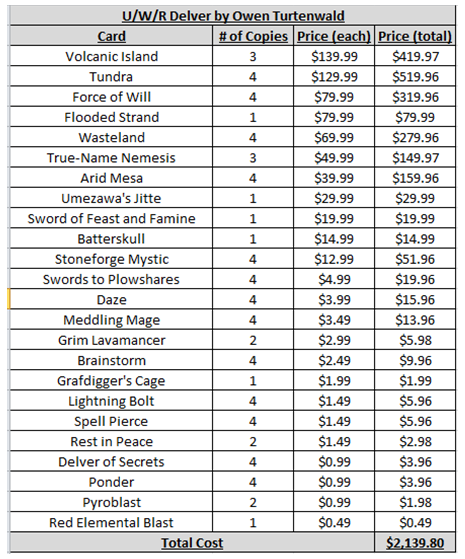
This is the deck that took down the whole tournament. Other than the lands, Force of Will, and True-Name Nemesis, it’s not that expensive by Legacy standards. Since True Name Nemesis can still be found in a retail product and some of these smalls could be easily traded for, you could probably get this deck for closer to $2,000 retail.
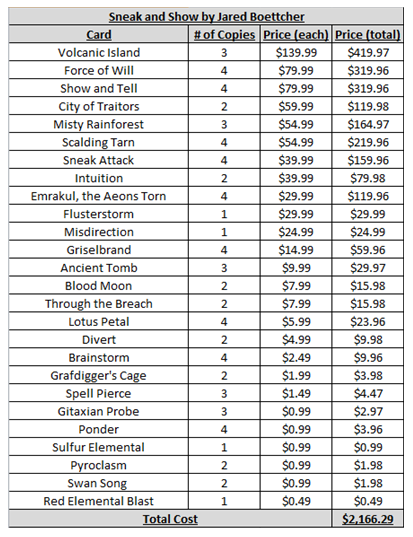
This deck seems like it should be more expensive than the Delver deck, doesn’t it? It’s chock full of expensive playsets of things like Show and Tell, Sneak Attack, and Emrakul. With no Tundras or Wastelands, though, the difference in price between these first two decks is fairly negligible.
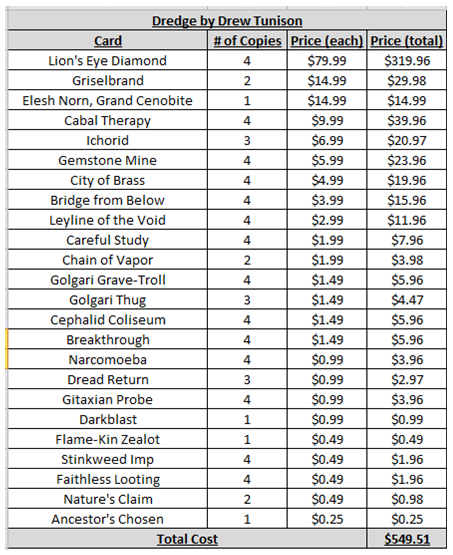
The major appeal of Dredge is that it’s a budget deck, but it’s still stunning to me just how cheap it really is compared to every other deck in the format. Once you have the Lion’s Eye Diamonds, it’s a matter of snapping up a couple of recently rotated Standard cards, some stuff from Modern Masters, and a few other scattered commons and uncommons.
I feel like if more casual players got a few games of Dredge under their belt and discovered a feel for the deck it would show up a lot more often.
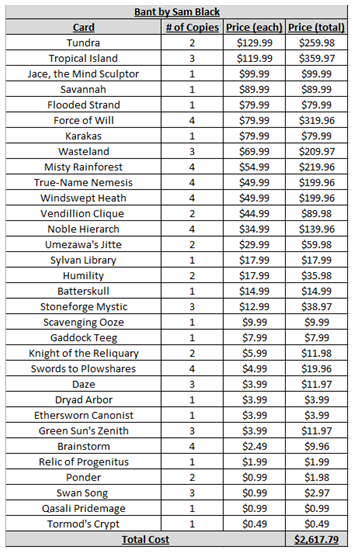
This is the most expensive deck yet mostly thanks to the lands. Running four copies each of True-Name Nemesis and Noble Hierarch in a three-color deck is going to tax your mana base no matter what, which is why it requires all the extra fixing. Even still, we’re safely under the $3K threshold.
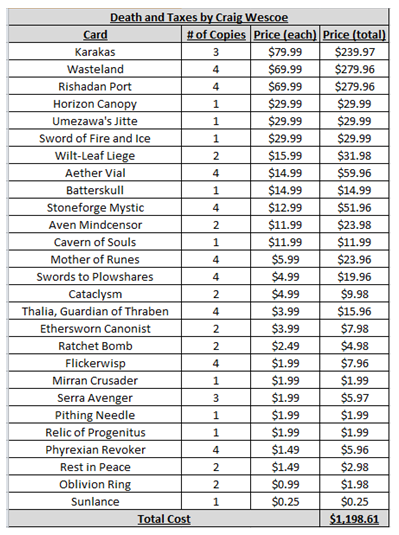
Monocolored decks tend to be reasonably priced, and this deck is no exception. Other than the three utility lands, nothing in this deck retails for more than $30, and the expensive cards are mostly one-ofs and two-ofs.
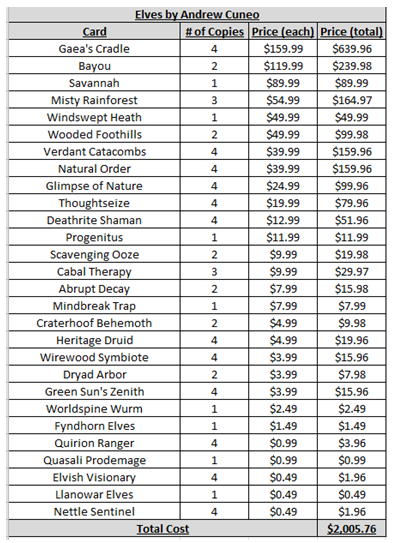
More than one quarter of the price of this deck is tied up in four copies of Gaea’s Cradle, a card that has done nothing but rise in price since the legend rule changed. While this is mostly a monocolored deck, playing black for the discard plan out of the sideboard is necessary. Elves used to be kind of a budget deck, but that is no longer true.
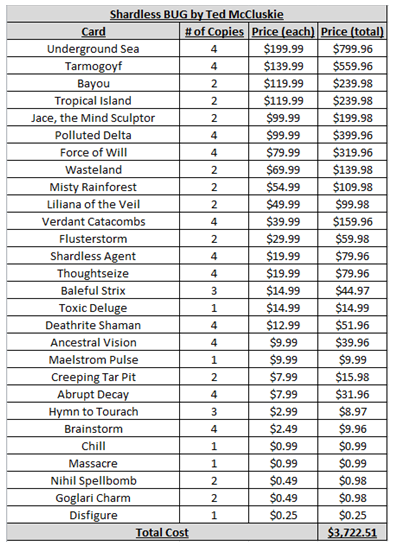
Finally, here’s a truly expensive Legacy deck! For the price of putting this one together, you could build any other deck we’ve seen so far plus one of the cheaper monocolored brews as well.
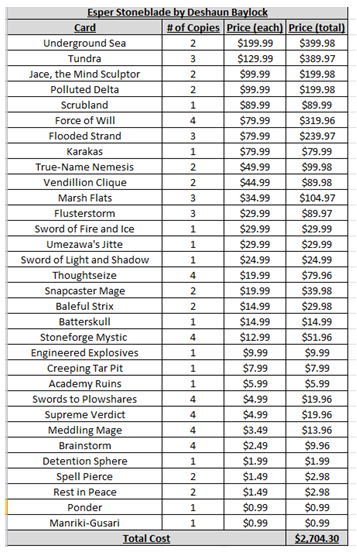
This last deck is a hybrid of several others we’ve seen. BUG, Bant, Delver, Stoneblade . . . all of these decks attack the metagame with cheap and resilient creatures, tempo, countermagic, and removal.
There are also a few other decks that missed the Top 8 but are still quite good, including other combo decks that sell for under $2,000.
How much Legacy costs right now depends entirely on how you approach it and how well equipped you are already. It’s possible to spend right around $500 on a deck that made Top 8 of a Grand Prix, and if you’re okay playing Dredge, you can probably trade for the small stuff pretty easily. A lot of the other decks come down in price considerably if you’ve already got playsets of fetch lands, duals, or cards like Wasteland and Force of Will that have been good roughly forever.
If you’re coming in cold and you want one of the top two decks from the latest Legacy GP, though, it’ll cost you right around $2,200. This is the price we’ll use as our benchmark for now.
The Current Cost Of Standard
Now that we’ve established the price for buying into Legacy right now, let’s do the same for Standard. How much is it going to cost you to buy each of the format’s top decks, including sideboards? This time I’ll be pulling lists from a few recent events. There are many more high-level Standard tournaments than Legacy ones, so the data is a little easier to compile.
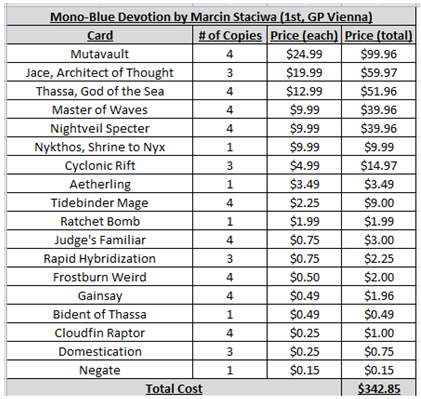
This is likely the strongest deck in the format right now. Not only did a variation of it win Pro Tour Theros, but it took down the GP in Vienna a few months later after the format had a chance to adjust to it. That kind of power and resilience is what you want in a top Standard deck. Other than the Mutavaults and Jaces, this is a pretty cheap deck—nothing in the Bonfire of the Damned or Voice of Resurgence circa summers 2012 and 2013 range.
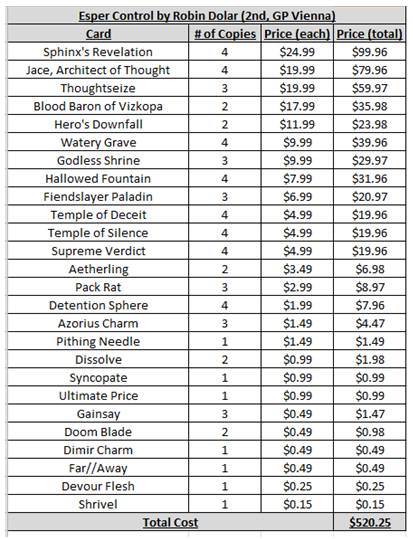
As per usual, it is the addition of a color and many more nonbasic lands that make this deck’s price so high. Sphinx’s Revelation is fairly pricey as well, as are the rare black removal and discard spells. Startlingly, this Standard deck is within spitting distance of a fairly good Legacy deck. Which would you rather have?
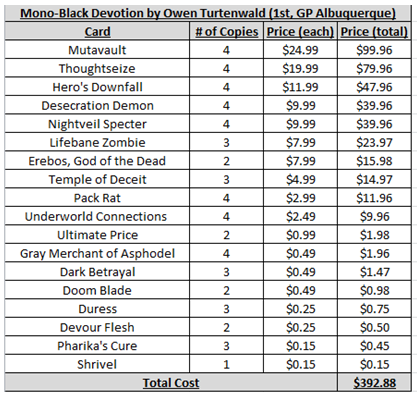
It sure looks like black and blue are the colors to beat in Standard right now, doesn’t it? The last few tournaments have been a sea of Mono-Blue Devotion, Mono-Black Devotion, and a little bit of Esper Control. This deck hasn’t proven itself as totally as the Mono-Blue variant, but I don’t suspect we’ve seen the last of it either.
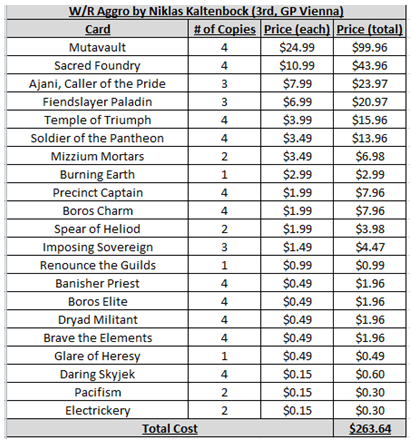
Want a nice budget deck in Standard? Here you go. More than half the cost is tied up in just eight cards—Mutavault and Sacred Foundry—and both are likely to be in demand for years to come. You can pick this build up for a tenth of the cost of most Legacy decks, and it’ll probably be reasonably competitive for at least the next few months.
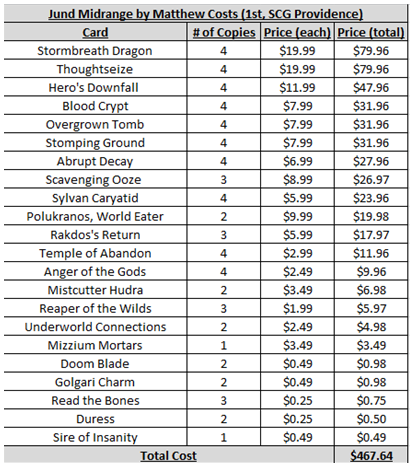
We could keep going and going with Standard, but I’m going to stop here because we’ve got a lot more ground to cover still. If you add all these decks up and average them out, Standard costs about $400 per deck right now. That’s fairly cheap too—I guarantee you Standard decks were quite a bit more expensive two months ago, and I expect they’ll be more expensive again a few months from now.
When does Standard become cheaper than Legacy? Let’s start with the simplest version of that calculation and add variables from there. If we assume that Legacy requires a one-time buy-in of $2,200 and no additional costs after that while Standard requires a yearly buy-in of $400, the chart looks like this:
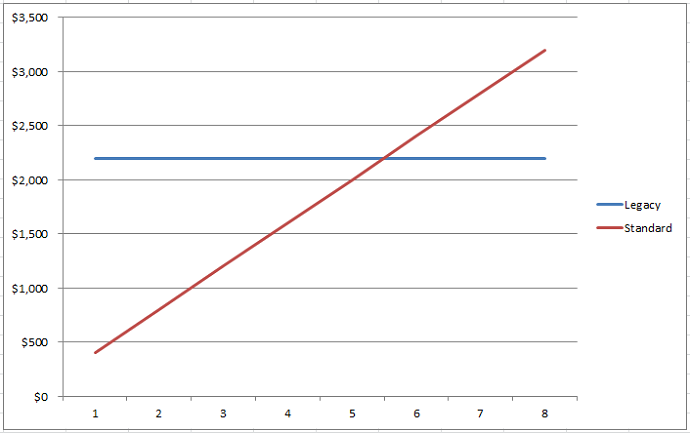
For the next five years, playing Standard would be cheaper than playing Legacy. Once you buy in for the sixth year of Standard, however, Legacy becomes the cheaper option and will remain so for as long as you continue playing Magic.
But that’s not quite how this game works, is it? Standard fluctuates wildly—there’s no guarantee that $400 a year would be enough. Legacy isn’t perfectly stagnant either. How would your deck designed to win one GP in November 2013 do with zero changes in the winter of 2018? In order to really figure out the answer to this question, we’re going to have to dig deeper.
The True Cost Of Legacy
The first problem is that even though Legacy cards never stop being legal the format still evolves. Cards are banned. New cards are printed. Elaborate metagames of rock/paper/scissors are played that eliminate some decks and bring others to the forefront.
Let’s start by taking a look at what the Legacy format was like five years ago. That puts us roughly in the range of autumn/winter 2008. There was no Legacy Grand Prix that season though—the one prior was on May 20, 2007 in Columbus. The one after was on March 8, 2009. For the purposes of this exercise, we’ll take a look at a few decks from each tournament.
Here are the Top 8 decks from that May 2007 Grand Prix:
1) Flash Counterbalance
2) Goblins
3) Mono-Black Aggro
4) Fish
5) Hulk Flash
6) Threshold
7) Hulk Flash
8) Mono-Black Aggro
Some of these decks did not age well. Back in 2007, the Flash + Protean Hulk combo dominated the format, and Flash was banned soon after. Goblins was a perennial budget deck that occasionally dialed it up for a tier 1 finish. In recent years, it has fallen out of favor altogether. Mono-Black Aggro was a deck that ran four copies of Order of the Ebon Hand for some reason. The fact that Order was still winning games in Legacy in 2007 will tell you just how much things have changed. Fish and Threshold feel like precursors to where the format is now: a couple of cheap creatures backed up with Jitte and things like Force of Will and Swords to Plowshares.
Here are the Top 8 decks from 2009:
1) CounterTop Goyf
2) CounterTop Goyf
3) The Rock
4) Dragon Stompy
5) The Rock
6) Ad Nauseam Tendrils
7) Threshold
8) Naya Burn
It’s fascinating to see how these decks have evolved from their 2007 counterparts. The CounterTop Goyf deck feels like the next evolution of the Flash Counterbalance deck but with Fish elements mixed in instead of the banned Flash/Hulk combo. The Rock isn’t really all that different from the previous generation’s Mono-Black Aggro deck—both ran four copies of Nantuko Shade, and while the rest of the cards were quite different, that one creature says a lot about what both decks were trying to do.
Threshold actually survived from 2007 to 2009 and made the Top 8 once again. Both decks ran full sets of Nimble Mongoose, though the newer deck backed them up with four Tarmogoyfs where the older one opted for Quirion Dryads and Werebears. Spell-wise both decks ran Brainstorm, Daze, Fire // Ice, Force of Will, Lightning Bolt, and Stifle. The 2007 edition backed those up with Mental Note and Serum Visions, while the 2009 build ran Rushing River, Ponder, Spell Snare, and Wipe Away. Both mana bases ran Flooded Strands, Polluted Deltas, Tropical Islands, and Volcanic Islands. Threshold 2007 backed those up with basic lands and Wooded Foothills, while Threshold 2009 ran a full set of Wastelands.
Here’s a breakdown—using 2013 prices, mind you—of what it would cost you to build the 2007 version of that deck and upgrade it to the 2009 variant:
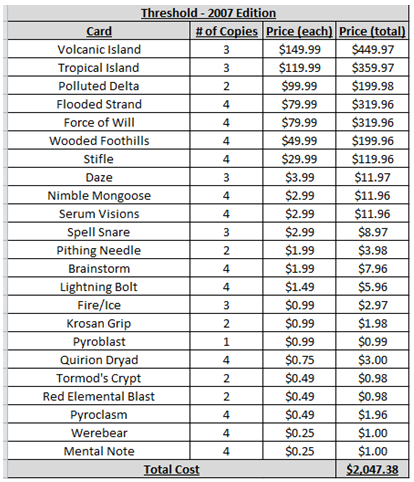
We can’t do a full analysis of this without historical pricing data, but it’s still interesting to see how it compares value-wise to a deck of today. Remember, this deck is seven years old and the cards in it are still valued at more than $2,000 dollars. All of the marquee cards have risen in price, and only the support spells—cards that would have been $10 and under at the time—have lost value. If you bought this deck in 2007, you’re probably pretty happy with that decision.
Here’s what it would have cost to upgrade your deck to the 2009 brew:
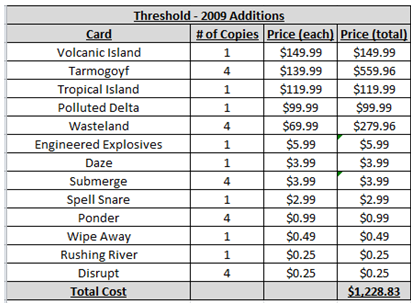
That . . . isn’t cheap. In order to tweak your deck—ostensibly THE EXACT SAME DECK—to the version that finished in the Top 8 two years later, you would have had to shell out another $1,200—roughly 60% of your initial investment—in order to make it happen.
Would it have been entirely necessary though? Probably not if you were only playing locally or in StarCityGames.com Opens as opposed to a Grand Prix or Pro Tour. Tarmogoyfs were available for under $400/set back then, and you could have easily played the deck with the 2007 mana base and only a few other small tweaks. Even still, most of your other 2007 decks would have been fairly obsolete by 2009.
Go forward in time a little further, though, and you’ll learn that none of these decks would have likely done much for you at Grand Prix Madrid in February of 2010. That tournament was dominated by Ad Nauseam Tendrils, Reanimator, Zoo, and CounterTop Progenitus. You can really see the format come to life over time as decks rise and fall in prominence—the "Naya burn" deck in 2009 was the predecessor to the Zoo decks of 2010, and the CounterTop Progenitus deck slots somewhere in between the CounterTop Goyf decks from 2009 and the modern Sneak and Show builds, both of which also have a lot in common with the Reanimator decks of 2010 and 2011. Legacy isn’t a format where decks burst into being out of nowhere like in Standard. Legacy decks evolve.
Ultimately, if you want to be a fairly serious Legacy player, you’ve got two real choices:
1) Pick a combo deck and stick with it until it dies. Then buy another one.
I’m counting Ad Nauseam Tendrils, Elves, and Dredge as combo decks along with things like Burn and Goblins where the "combo" is "whatever seven or eight Goblins/burn spells you can resolve." These decks all tend to be very linear, which means that there isn’t a lot of room for creativity or upgrades.
This is good if you’re on a budget because a deck like Ad Nauseam Tendrils probably isn’t going to change much over the next five or six years. If you buy in now, you can master the deck and play it in events for quite some time. These decks also tend to be fairly cheap aside from a few flagship pieces.
The downside with these decks is the same reason you might be attracted to them—they can’t really evolve in the way Force of Will decks can. Goblins aren’t great right now because WotC hasn’t printed a new awesome Goblin in years. Creatures that were powerful back in Onslaught block just aren’t as good anymore. If a newer faster deck comes along or the right piece of hate is printed, these decks may become worthless overnight.
2) Begin collecting the true staples of the format.
Legacy decks change all the time. However, the most expensive Legacy cards haven’t changed much at all.
Pricey Legacy cards tend to fall in one of two categories: multi-deck staples (Flooded Strand, Force of Will) and single-deck flagships (Show and Tell, Natural Order). The former tend to be good in many decks for years, while the latter provide the engine for a dominant deck and are thus more likely to be banned or to fall out of favor.
If you want to have the flexibility to adjust your Legacy deck as the metagame shifts, you should try to eventually build a binder that contains the following cards:
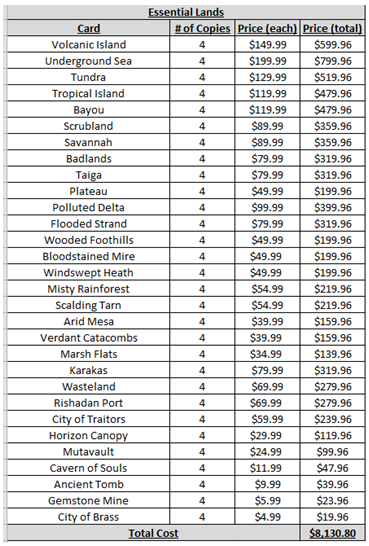
Some of these lands are more important than others. The Naya duals and fetches have fallen out of favor recently with the downfall of Zoo and Maverick because they are usually only good in aggressive decks. Depending on what you want to start with, you can hone in on the BUG lands, RUG lands, or colorless all-stars like Wasteland and Rishadan Port. Eventually, though, you’re going to need four of each dual land and four of each fetch if you want to really feel like all of Legacy is open to you.
Now let’s take a look at the creatures:
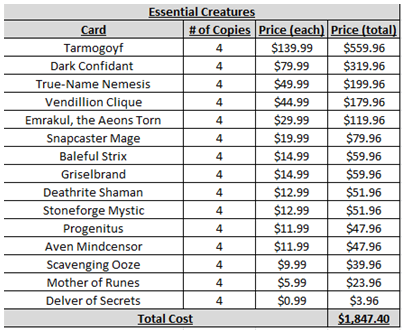
Again, you can prioritize a lot here. If you like playing Fish-style decks, focus on cards like Tarmogoyf, Stoneforge Mystic, and Delver of Secrets. If you like playing Sneak and Snow/Reanimator-style decks, focus on the fatties.
You can certainly pick nits with this list—Thalia isn’t on here despite seeing play in a Top 8 deck, and Dark Confidant is here even though it has fallen out of favor recently—but I’m trying to base this on data from the past couple of years. Other creatures that have been good in the past like Knight of the Reliquary might make a comeback as well. For now, though, this is a pretty good starting point. If you really want to get into Legacy, start reading everything you can about the format and make your own list of desired staples.
Lastly, let’s look at the spells you’ll need:
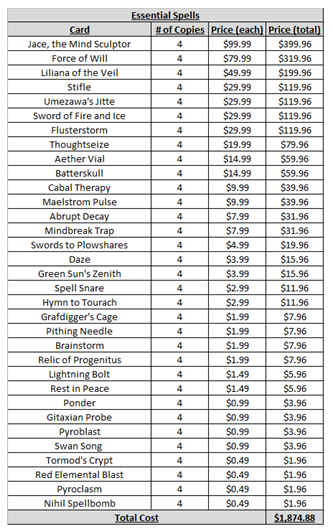
You can make a reasonable argument for another two dozen cards here as well, and you probably don’t need the full four copies of things like Sword of Fire and Ice and Batterskull now that Stoneforge Mystic exists. I also expect that the graveyard hate of choice will continue to rotate. Again, though, this list is a pretty good place to start.
This list also showcases what a good job Wizards of the Coast has done keeping the price of many common and uncommon staples down. They’ve printed enough copies of things like Brainstorm and Swords to Plowshares to saturate the market. Even though these cards are among the most powerful in the format, you can pick them up for next to nothing.
Overall, you’re looking at spending just under $12,000 retail if you wanted to buy all of these cards today, which is something exactly no one can afford. That doesn’t even buy you the archetype staples like Sneak Attack or any new cards that are released and become staples down the line. Buying into Legacy as a whole might have been viable at one point, but you won’t be doing it now without a large bankroll, a ton of luck, or some serious trading chops.
That doesn’t mean it doesn’t make sense to start though. Legacy has one advantage worth talking a little more about—all of these cards will hold their value for years to come. Other than the fetch lands, which will all be reprinted someday, there are close to zero cards on this list in danger of a crash unless Magic as a whole comes tumbling down. Most of them will even continue to rise in price. Your Legacy collection should be worth more than it is now in five years. Not so with Standard.
The True Cost Of Standard
I know what I said earlier, but let’s be honest—spending just $400 a year on a competitive Standard deck is a pipe dream. The format doesn’t change once a year; it shifts every couple of months. If you’re a serious player, you can’t sit around and wait for the prices to drop either. You will have to preorder some cards, hope to get lucky, and switch your deck two or three times between September and the end of the following August. Standard is brutal.
A lack of historical pricing data hurts this analysis even more than it did for Legacy, so we’ll have to get a little bit creative. Unlike Legacy, where some comparison to Modern prices is reasonable, the price of something like Cascade Bluffs today has no bearing whatsoever on what the card was worth in 2008, so it doesn’t make sense to look back that far.
We can’t use essential lands, creatures, and spells the way we did for our Legacy analysis either. Standard decks are way too ephemeral, and most spells are only good in one or two decks. It would take hundreds of hours at least to truly parse the data, attempting to figure out the average number of Standard cards a given player is going to go through in a given year depending on how much he or she plays. I don’t have time to do that—not if you want me to write about anything else between now and May—so I’m going to have to get a little holistic here instead.
Here’s my estimate for true year-over-year Standard costs:
Playset of dual lands from each year’s block: $300.
This averages out to $7.50/land, which accounts for the fact that most years have $5/land fixing while some have $10 or $15 lands. I’m separating out the lands because they’re at the heart of deckbuilding and every good Standard player always tries to acquire them first.
A complete teardown/rebuild twice per year during hype season: $800.
Earlier in the article, we estimated the cost of a Standard deck to be around $400. That’s in mid-December though during the second quietest part of the year for Standard prices after late July and August. In early fall and spring—the two seasons when the format shifts the most—you’re going to be paying quite a bit more for the new cards you want. I’m assuming you’re a reasonably shrewd player and not chasing stupidly hyped planeswalkers, so I’m going to estimate a conservative $400/deck minus lands.
Reinforcements, tweaking, and day-of pick-ups: $600.
This is a fairly conservative budget of just $150 per set each year for cards that weren’t in your original decklist. It also includes any purchases that need to be made on the morning of a PTQ or because you randomly saw a cool idea online and wanted to try it out. It doesn’t include the cost of booster boxes, so if you’re the type that buys one each time a new set comes out make sure you add that to the total.
That brings the cost of a typical Standard grinder up to about $1,500 per year.
Let’s revisit our chart and see how Standard and Legacy compare now, shall we?
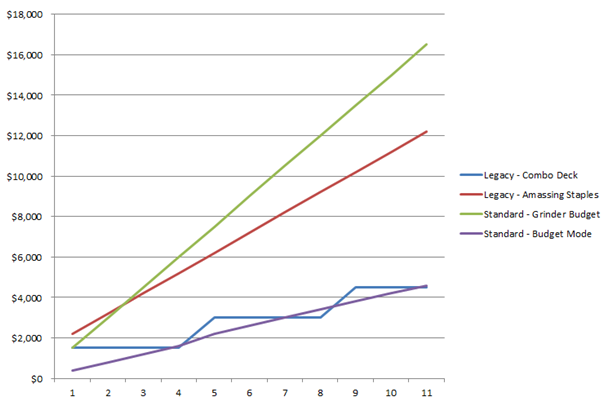
This chart compares four different approaches to Legacy and Standard.
The first approach—building a Legacy combo deck and sticking with it—accounts for the purchase of a new $1,500 deck every three years. This is the average cost of something like Ad Nauseam Tendrils, Dredge, or Elves, all of which are fairly insular decks that don’t generally require expensive multicolored mana bases. These decks are likely to be competitive for a couple of years at a time, but they may become obsolete and require a complete replacement at any time.
The second approach—amassing Legacy staples slowly over many years—requires an immediate outlay of $2,200 to buy a competitive Legacy deck right away. It also factors in $1,000 a year toward building that Legacy binder and improving/changing the deck. Ideally, you will collect all of the lands and spells you’ll ever need while constantly tweaking your brew.
The third approach—going all out with Standard—requires about $1,500/year to be spent exclusively on brand-new cards. This budget allows the player to generally be assured of having the best deck for any given event.
The final approach—playing Standard on a budget—allows for an FNM player to build a single good deck each year.
There are a few interesting things worth discussing as we begin our wrap-up. The first is that playing budget Standard and budget Legacy will both cost you about the same amount of money over the long haul. Your budget Legacy deck is going to be Top 8-worthy for longer too—a $400 Standard deck might be hated out of the format a few weeks later, while a $1,500 Legacy deck could take down large tournaments for years.
Being fully on top of Standard catches up with Legacy very quickly in price, though it allows you to be much more flexible and play many different kinds of Magic games each year. The $1,500/year Standard player is going to have the opportunity to build multiple decks a season in a quickly shifting format, while the $2,200 + $1,000/year Legacy player is going to have to wait a couple years before being able to tweak their deck beyond a couple of very similar archetypes.
Standard has other advantages too. If you draft every week, you’ll eventually collect a bunch of Standard cards whether you play the format or not. This will help reduce the cost by quite a bit, especially if you win a lot. You can also deduct cards that you open at Prerelease and release events from your budget. It’s far easier to trade with and for Standard cards than Legacy cards too.
The chart doesn’t factor in depreciation due to set rotation, though, which is a big factor swinging the pendulum back toward Legacy. Your Standard collection will drop in price every single year, and most people will sell their cards over the summer for half of what they paid. Legacy players, on the other hand, will hold on to everything.
A truer comparison of these two formats might show Standard players having spent roughly $9,000 after ten years—not $15,000—but with only $1,500 worth of cards left to show for it, having sold the rest of them. The Legacy player would have spent closer to $11,000, but he or she would still own every single one of those cards at the end of the decade.
There are also a lot more chances to play Standard than Legacy. If you attend FNM each week, traverse the PTQ circuit, or like to play in GPs, Standard is your game. Unless you live right next to a really awesome shop, your Legacy opportunities are limited to casual games with friends, a few large regional tournaments, whatever SCG Open Series travel to your area, and likely one single Grand Prix in the US each year. For many players, buying into Legacy is a cost they would need to endure in addition to Standard, not instead of Standard.
Is Legacy cheaper than Standard? In a way, yes. If you are the sort of player who plans to play Magic for at least the next three years, you’ve got a reasonable amount of cash for the initial buy-in, and you only play Constructed Magic every couple of weekends or have a large Eternal playgroup, Legacy is the way to go. This describes a lot of players in their mid-twenties and up with jobs and families, which is why Legacy keeps growing in popularity among Magic’s adults. If Magic is a part of your life instead of being your entire life, give Legacy a shot.
If you’re already playing Standard constantly, though, chances are you aren’t giving up the thrill of new decks and excitement of a rapidly shifting metagame for a format where changes happen much more gradually and the dollar amounts to upgrade or change your deck get very big very quickly.
You still might want to consider picking up Legacy though. The format may slow down someday because the staples get too expensive, but we’re still a long way from that coming to pass. As these charts show, buying into Legacy still compares rather favorably to buying into Standard. Reports of the format’s demise have been greatly exaggerated.
